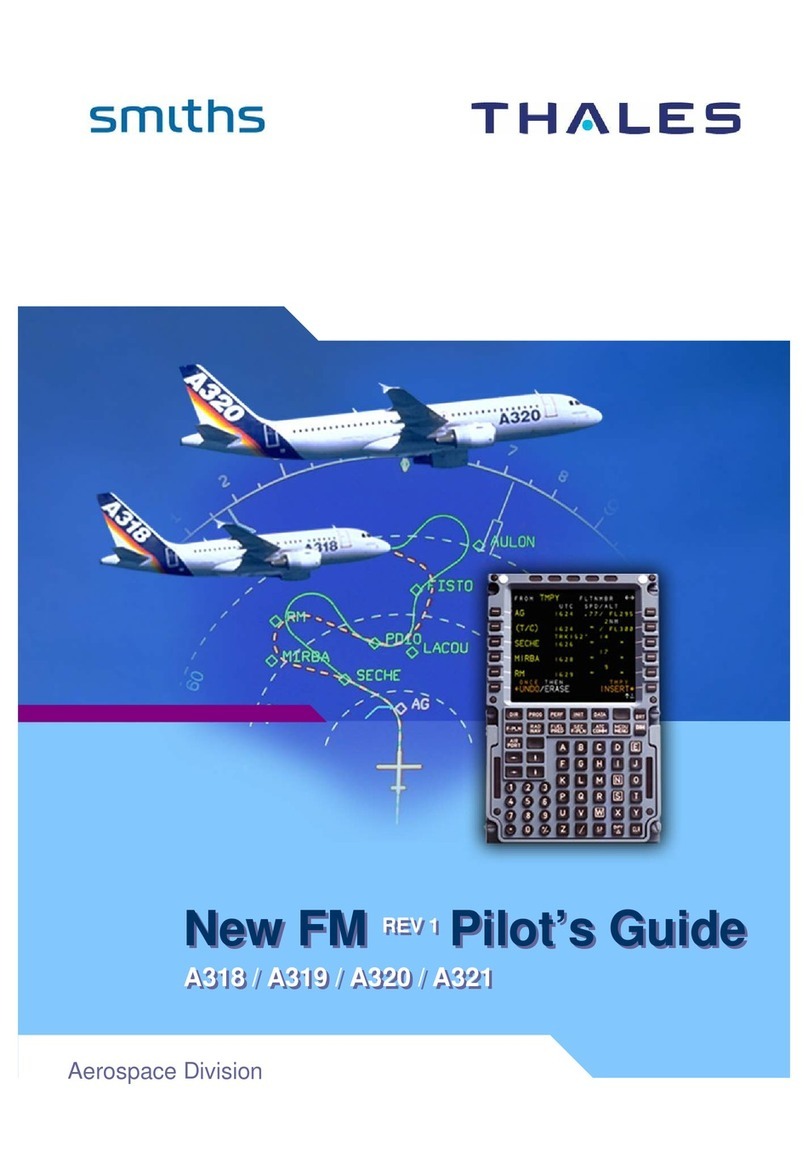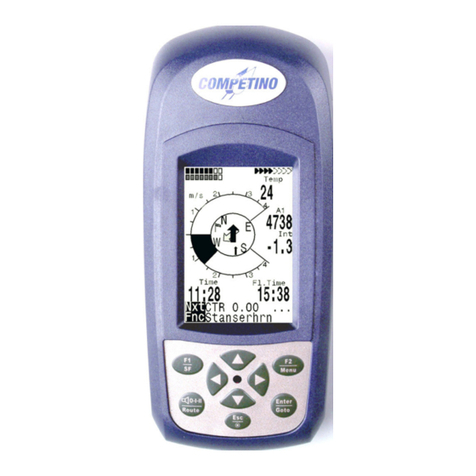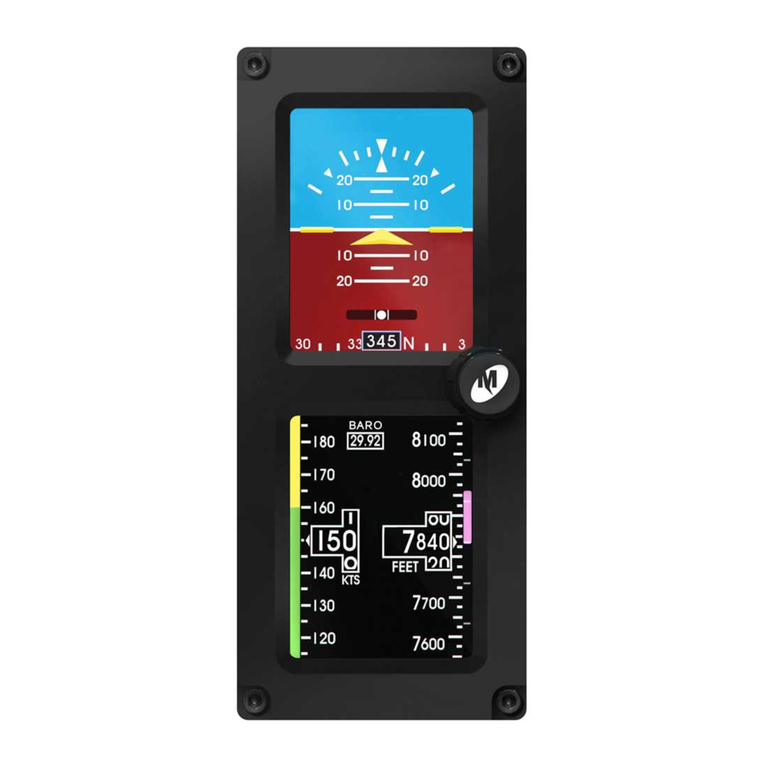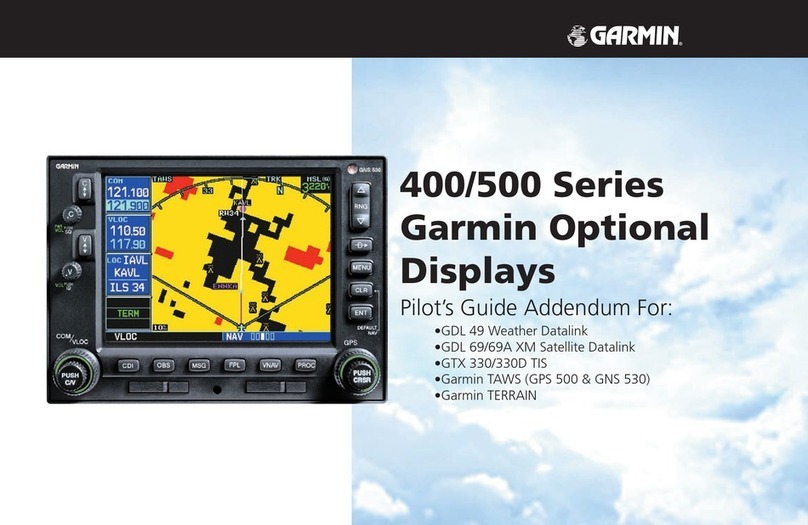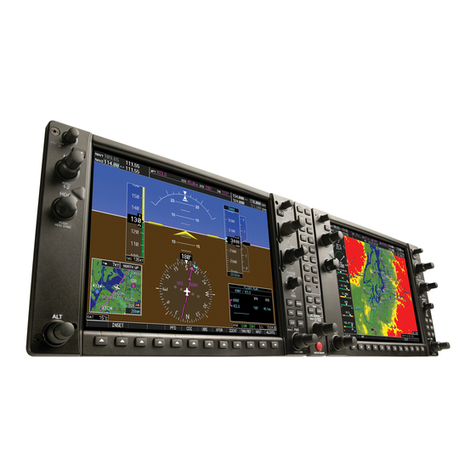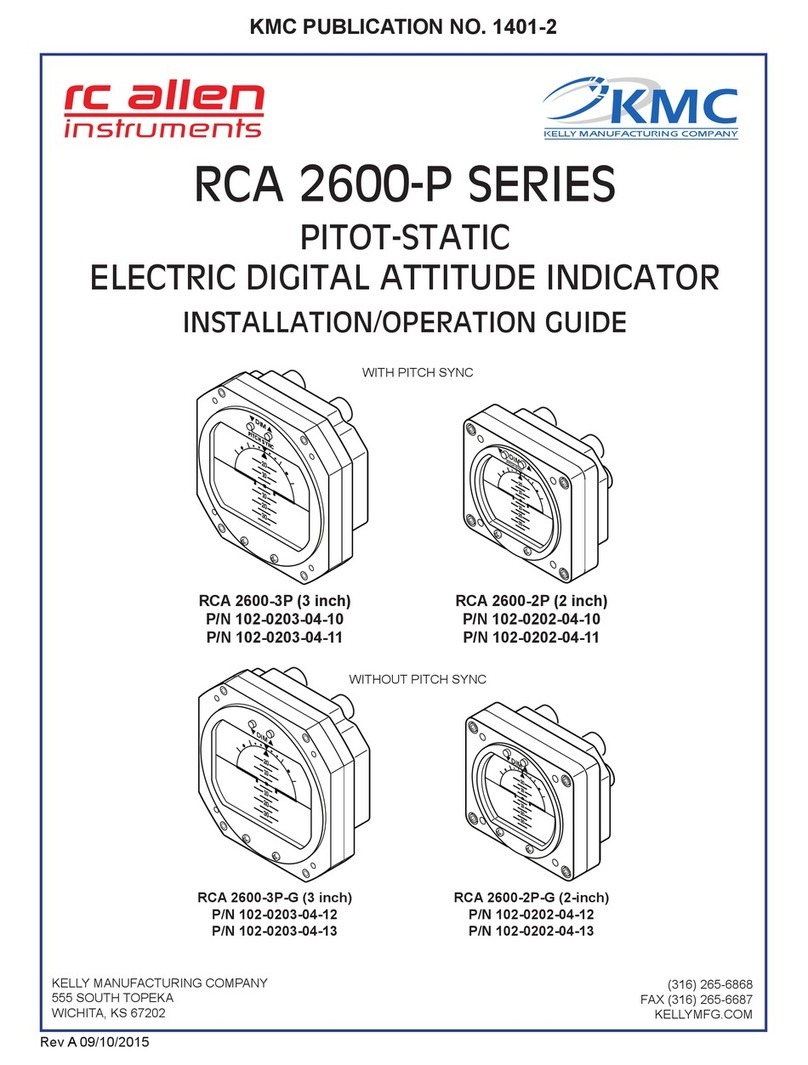Sporty's E6B-F User manual

SPORTY'S E6B-F
ELECTRONIC FLIGHT COMPUTER
Sporty's E6B-F Flight Computer is designed to perform 23 aviation functions and 14 standard conversions, and includes timer and clock
functions.
We hope that you enjoy your E6B-F Flight Computer. Its use has been made easy through direct path menu selection and calculation
prompting. As you will soon learn, Sporty's E6B-F is one of the most useful and versatile of all aviation computers.
Copyright ©2008 by Sportsman's Market, Inc.
Version 08A
1

2
CONTENTS
BEFORE USING YOUR E6B-F ..........................2
DISPLAY SCREEN....................................... 3
PROMPTS AND LABELS ................................3
SPECIAL FUNCTION KEYS.............................4
ARITHMETIC FUNCTIONS ..............................5
AVIATION FUNCTIONS .................................5
CONVERSIONS ...........................................5
CLOCK FUNCTION.......................................6
ADDING AND SUBTRACTING TIME ..................7
TIMER FUNCTION........................................7
PRESSURE AND DENSITY ALTITUDE ...............8
PLANNED TRUE AIRSPEED ............................8
HEADING AND GROUND SPEED ......................9
LEG TIME ..................................................9
FUEL REQUIRED........................................ 10
CROSSWIND, HEADWIND AND TAILWIND....... 10
ACTUAL TRUE AIRSPEED............................ 11
WIND SPEED AND DIRECTION...................... 11
GROUNDSPEED ......................................... 12
FUEL PER HOUR ....................................... 12
PLANNED MACH NUMBER ...........................13
REQUIRED TRUE AIRSPEED ......................... 13
REQUIRED CALIBRATED AIRSPEED ............... 14
DISTANCE FLOWN .................................... 14
WEIGHT AND ARM .................................... 15
WEIGHT AND MOMENT ............................... 16
ENDURANCE ............................................ 17
ACTUAL MACH NUMBER ............................ .18
PERCENT MAC.......................................... 18
REQUIRED RATE OF CLIMB ......................... 19
REQUIRED RATE OF DESCENT......................19
TOP OF DESCENT .....................................20
SPECIFIC RANGE .......................................20
APPENDIX A: SAMPLE PROBLEMS.................21
BATTERY REPLACEMENT ............................23
WEIGHT AND MEASURE CONVERSIONS ..........24
TROUBLESHOOTING AND CARE....................24
WARRANTY INFORMATION ..........................25
NOTES....................................................25
BEFORE USING YOUR E6B-F
Sporty's E6B-F Flight Computer requires two 3V Lithium
batteries model number CR2032 Sporty’s Product number
2098A (not included) for operation. New batteries should be
installed in the battery compartment located in the lower rear
of the computer. Make sure that battery polarity is aligned
correctly.
An opaque plastic film has been placed over the display screen
to protect your E6B-F during shipping. This film is easily
removed by peeling up one corner and pulling gently.
This manual is designed to offer an introduction to the
operation of the E6B-F. For each calculation, a sample problem
has been given.
In order to save power, the display screen automatically turns
off approximately 4 minutes after the last keystroke. However,
the internal clock and timer will continue to run. If the timer is
counting down, it will not shut off for approximately thirty
minutes.

This multi-function computer is authorized and acceptable for
use during FAA and Canadian written tests. All memory is
erased by removing and reinstalling the batteries. NOTE: This
also removes clock settings. References: FAA Advisory Circular
60-11B and FAA Order 8081D, Conduct of Airmen Written
Tests, April 10, 1989.
3
DISPLAY SCREEN
T-SCN WDIR -LEMAC
WT PALT DIST MCLM
I°C ARM -GS RATE
WSPD T°C ZULU
MOM CAS -%MAC RQ/DN
RWY CRS HOME TIME
CG TAS -FHP
IALT MROC
X-WIND RF -MAC SPRNG
GS MACH# BARO CRALT
8888
H-WIND GW -FUEL FIXDIS
HDG DALT LOCAL %
8888
NAUT CALC CONV TIMER
°C FEET SPCRANGE TOP DSCN REQ/DSCN
WT/ARM WT/MOM %MAC P-D/ALT PLAN TAS
HDG/GS LEG TIME FUEL REQ X/H-WIND ACT TAS
WIND GS FPH PLAN M# REQ TAS
REQ CAS DIST FLN ENDUR ACT M# REQCLIMB
The figure above shows all possible displays, prompts and labels on
the E6B. The numeric display is surrounded by labels for specific
problems. Below this are lines of text representing display prompts,
labels, and aviation functions. Aviation functions available on the E6B
will remain visible whenever the power is on. The display prompts
and labels are only visible when in use.
8888
PROMPTS AND LABELS
8888 WT: Weight
I°C: Indicated Temperature in Celsius
8888 W SPD: Wind Speed
MOM: Moment
8888

4
RWY: Runway
CG: Center of Gravity
X-WIND: Crosswind
GS: Ground Speed
H-WIND: Headwind
HDG: Heading
W DIR: Wind Direction
P ALT: Pressure Altitude
ARM: Arm
T°C: True Temperature in Celsius
CAS: Calibrated Air Speed
CRS: Course
TAS: True Air Speed
RF: Reduction Factor
MACH#: Mach number
GW: Gross Weight
D ALT: Density Altitude
LEMAC: Leading Edge Mean Aerodynamic Chord
DIST: Distance
ZULU: Coordinated Universal Time Clock Label
PROMPTS AND LABELS (cont.)
%MAC: Percent Mean Aerodynamic Chord
HOME: Home Time Clock Label
FPH: Fuel Per Hour
TIME: Time
I ALT: Indicated Altitude
MAC: Mean Aerodynamic Chord
BARO: Altimeter Setting in Inches (Barometer)
FUEL: Fuel
LOCAL: Local Time Clock Label
°C: Temperature in Celsius Label
FEET: Feet
NAUT: Nautical
CALC: Calculator Function
CONV: Conversion Function
MCLM: Minimum Climb
MROC: Required Rate of Climb
%: Climb Gradient
CRALT: Crossing Altitude
FIXDIS: Fix Distance
RQ/DN: Required Descent Rate
SPRNG: Specific Range
RATE: Descent Rate
T-DCN: Top of Descent

SPECIAL FUNCTION KEYS
ON Turns power on and resets E6B-F to main menu.
OFF Turns display screen off.
TIMER Starts and stops timer function.
ENTER Selects menu function and enters data input.
=Totals regular calculator functions.
CONV Converts keys to alternate functions.
CLK Controls display and setting of clocks.
C Clears current input line.
Controls function menu cursor. The function on
which cursor is located will blink. Arrows return
computer to main menu when in an aviation function
mode.
5
+/- Changes negative to a positive and positive to a negative.
A negative number will be denoted by a minus sign near
the upper right hand corner of the number. For example,
to input -17:
Press 1 7 +/-
And the screen will read 17.-
ARITHMETIC FUNCTIONS
7 8 9
÷
4 5 6 X
1 2 3 -
0 • =+
Your E6B-F performs all of the standard arithmetic functions
with the keys shown above (addition, subtraction,
multiplication, and division). These functions as well as any
conversions can be performed at any time, even while
performing an aviation function. The E6B-F will display up to six
digits of the answer.
The =key should be used to compute any arithmetic
function.
AVIATION FUNCTIONS
The aviation function menu is displayed on the bottom of the
screen. Your E6B-F will automatically save computed values
from one aviation function to another. To override this option,

key in new value when prompted. The E6B-F will save true
airspeed, ground speed, time, and fuel per hour functions. It will
also save cumulative weight and balance totals.
CONVERSIONS
Conversions are displayed above the appropriate key. All
conversion functions are keyed into the computer in the same
manner. For example, to convert decimal hours to hours,
minutes and seconds:
Input4 . 2 6 2 5
Press CONV
6
Press 6
The answer, 04:15:45, will appear on the display.
There are no conversion keys for kilometers to statute miles or
statute miles to kilometers. To convert from kilometers to
statute miles, first convert kilometers to nautical miles, then
nautical miles to statute miles.
To convert statute miles to kilometers, first convert from
statute miles to nautical miles, then nautical miles to
kilometers.
NOTE: Conversions may be made at any time and during any
other function. For example, if a calculation prompts for
temperature in Celsius and only Fahrenheit is available, the
Fahrenheit can be entered and converted without exiting the
calculation.
CONVERSIONS (cont.)
0pounds to kilograms
•kilograms to pounds
1feet to meters
2meters to feet
3Fahrenheit to Celsius
-Celsius to Fahrenheit

4nautical miles to kilometers
5kilometers to nautical miles
6decimal hours to hours, minutes, seconds
Xhours, minutes, seconds to decimal hours
7nautical miles to statute miles
8statute miles to nautical miles
9U.S. gallons to liters
÷liters to U.S. gallons
7
CLK CLK1
CLOCK FUNCTION
The E6B-F has three clocks that run simultaneously. They are
labeled as ZULU (#1), HOME (#2) and LOCAL (#3).
To display clocks (repeat to cancel):
Press CLK then press 0
To set 11:25:00 on ZULU clock:
Press CLK then press 1
Key in 11 then press :
Key in 25 then press CLK to start clock
To set hours for HOME and LOCAL clocks:
Press CLK then press 2(for HOME)
or 3(for LOCAL).
To synchronize minutes and seconds on clocks, press:
ADDING AND SUBTRACTING TIME
Time can be entered into the E6B-F in either decimal hours or
as hours, minutes and seconds. To enter in decimal hours,

simply key in a normal decimal number. For example, entering
2.75 hours is the same as entering 02:45:00.
To key in time in hours, minutes and seconds mode, the :
key must be used. For example, to enter 3 hours, 14 minutes
and 25 seconds:
Key in 3then press : and key in 14
Press :and key in 25
The display will read 03:14:25
To key in 5 hours even:
Key in 5and press :
The display will read 05:00:00
To key in 15 seconds:
Key in 0then press :twice and key in 15
The display will read 00:00:15
Time can be added in either mode; times from different modes
can also be added without converting.
For example, to add 3.45 hours and 2:45:00:
Key in 3.45 and press +
Key in 2:45 and press =
The display will read 06:12:00.
TIMER FUNCTION
The timer can be used in either a count down or count up
mode.
To enter TIMER mode, press TIMER
Once in TIMER mode, the TIMER key acts as a start/stop
button. The timer is set to count up.
To change counting direction, press CONV TIMER
The timer can be cleared by pressing:
C CLK TIMER
To input a time other than 00:00:00 :
Press Cthen input a time in hours, minutes, seconds
(HMS) or decimal format. then press CLK TIMER . To
count up, press TIMER again
To count down, press CONV TIMER
Upon reaching zero in count down mode, the timer will count
time since zero was reached. To denote this, a negative sign
will appear to the right of the timer. The count down timer can
be used as a reminder of when to switch fuel tanks, to fly a
non-precision approach (LEG TIME function) or measuring
ground speed from one checkpoint to another checkpoint (GS).
8

Any function requiring time to be entered, the timer may be
used by pressing TIMER ENTER when prompted for
time. The
9
timer can be set to 00:00:00 or another time and then count
up or down in these calculations.
Activating the count down timer will keep the screen from
turning off until approximately thirty minutes without use.
PRESSURE AND DENSITY ALTITUDE
(P-D/ALT)
This function will compute the pressure and density altitude
given the indicated altitude, barometric pressure (altimeter
setting in inches), and true temperature in Celsius. In this
example, indicated altitude is 10,000 feet, the barometer is
29.94 inches, and the temperature is 5°C.
Select P-D/ALT from main menu
Press ENTER and the display will prompt for IALT
Key in 10000 and press ENTER
The display will prompt for BARO
Key in 29.94 and press ENTER
The display will prompt for T°C
Key in 5and press ENTER
The display will read:
PLANNED TRUE AIRSPEED
(PLAN TAS)
This function is used to calculate true airspeed for preflight
planning. It will compute the true airspeed in knots and Mach
number and density altitude, given the pressure altitude,
temperature, and calibrated airspeed in knots. In this example,
pressure altitude is 10,000 feet, temperature is 2°C, and CAS
is 200 knots.
Select PLAN TAS from main menu
Press ENTER and the display will prompt for PALT
Key in 10000 and press ENTER
The display will prompt for T°C
Key in 2and press ENTER
(FLASHING) P ALT 9980.
5.
10000.
29.94
11093.
I ALT
T°C
BARO
(FLASHING) D ALT

The display will prompt for CAS
Key in 200 and press ENTER
The display will read:
P ALT
T°C
CAS
(FLASHING) TAS
(FLASHING) MACH#
(FLASHING) D ALT
10000.
2.
200.
234.7
0.36
10775.
HEADING AND GROUND SPEED
(HDG/GS)
This function will compute heading and ground speed given
wind direction, wind speed, course, and true airspeed. In this
example, the wind is from 270° at 20, course is 180°, and true
airspeed is 185.
Select HDG/GS from main menu
Press ENTER and the display will prompt for WDIR
Key in 270 and press ENTER
The display will prompt for WSPD
Key in 20 and press ENTER
The display will prompt for CRS
Key in 180 and press ENTER
The display will prompt for TAS
Key in 185 and press ENTER
The display will read:
270.
20.
180.
185.
183.9
186.2
W DIR
W SPD
CRS
TAS
(FLASHING) GS
(FLASHING) HDG
LEG TIME
(LEG TIME)
This function computes the time required to fly a particular
distance given distance and ground speed. In this example,
distance is 25 and ground speed is 185.
Select LEG TIME from main menu
10
Press ENTER and the display will prompt for DIST

11
Key in 25 and press ENTER
The display will prompt for GS
Key in 185 and press ENTER
The display will read:
P ALT
R F
:25.
185.
00:08:06
G S
TIME (FLASHING)
DIST
After LEG TIME is calculated, the count down timer can be
activated starting at the calculated time by pressing CONV
TIMER
FUEL REQUIRED
(FUEL REQ)
Since it is one of the most important aviation calculations, this
function flashes on the main menu when the computer is
turned on. It calculates fuel requirements given time and fuel
per hour consumption. In this example, flying time is 3 hours
15 minutes and fuel per hour consumption is 14 gallons.
Select FUEL REQ from main menu
Press ENTER and the display will prompt for TIME
Key in time of 3 hours, 15 minutes and press ENTER
The display will prompt for FPH (fuel per hour)
Key in 14 and press ENTER
The display will read:
45.5
03:15:00
14 FPH
TIME
FUEL (FLASHING)
NOTE: The Fuel Required function computes fuel consumption
only; it does not take required fuel reserves into account.
CROSSWIND, HEADWIND AND TAILWIND

(X/H-WIND)
This function computes the crosswind component and
headwind or tailwind component given wind direction, wind
speed and runway number. In this example, the wind is from
270° at 20, and the runway number is 30. Note that the
runway number, not heading, is asked for, and therefore 30
should be entered, not 300.
Select X/H-WIND from main menu
Press ENTER and the display will prompt for WDIR
Key in 270 and press ENTER
12
The display will prompt for WSPD
Key in 20 and press ENTER
The display will prompt for RWY
Key in 30 and press ENTER
The display will read:
270.
20.
30.
10.
17.3
RWY
(FLASHING) X-WIND
W SPD
W DIR
(FLASHING) H-WIND -
-
Right crosswinds are shown as positive numbers, while left
crosswinds are shown as negative numbers. A positive value
for H-WIND denotes a tailwind, while a negative value
denotes a headwind.
ACTUAL TRUE AIRSPEED
(ACT TAS)
This function calculates true airspeed, Mach number and
density altitude given pressure altitude, indicated temperature
in Celsius and calibrated airspeed. In this example, pressure
altitude is 10,000 feet, temperature is 3°C, and airspeed is
200.
Select ACT TAS from main menu
Press ENTER and the display will prompt for PALT
Key in 10000 and press ENTER
The display will prompt for I°C
Key in 3and press ENTER
The display will prompt for CAS
Key in 200 and press ENTER
The display will read:

13
WIND SPEED AND DIRECTION
(WIND)
This function calculates wind speed and direction given course,
true airspeed, ground speed, and heading. In this example, the
course is 355°, true airspeed is 200, ground speed is 170, and
the heading is 350°.
Select WIND from main menu
Press ENTER and the display will prompt for CRS
Key in 355 and press ENTER
The display will prompt for TAS
Key in 200 and press ENTER
The display will prompt for GS
Key in 170 and press ENTER
The display will prompt for HDG
Key in 350 and press ENTER
The display will read:
GROUNDSPEED
(GS)
This function calculates groundspeed given distance and time.
In this example, distance is 18, and time is 7 minutes.
Select GS from main menu
Press ENTER and the display will prompt for DIST
Key in 18 and press ENTER
The display will prompt for TIME
Key in time of 7 minutes and press ENTER
The display will read:
10000.
3.
200.
232.
0.36
10044.8
I°C
(FLASHING) MACH#
P ALT
CAS
(FLASHING) D ALT
(FLASHING) TAS
324.2
34.
355.
200.
170.
350.
CRS
(FLASHING) W SPD
GS
HDG
TAS
(FLASHING) W DIR

GS (FLASHING)
18.
154.3
00:07:00
TIME
DIST
NOTE: Times can be imported from the timer for ground speed
calculations. This can be done by pressing TIMER ENTER
when the computer prompts for TIME to use the timer’s
current value.
FUEL PER HOUR
(FPH)
This function computes fuel per hour given time and total fuel
consumed. In this example, time is 3 hours 15 minutes, and
fuel consumed is 45.5 gallons.
Select FPH from main menu
Press ENTER and the display will prompt for FUEL
Key in 45.5 and press ENTER
The display will prompt for TIME
Key in time of 3 hours, 15 minutes and press ENTER
The display will read:
FPH (FLASHING)
03:15:00
14.
45.5
TIME
FUEL
PLANNED MACH NUMBER
(PLAN M#)
This function will compute the true airspeed given the true
temperature in Celsius and the Mach number. In this example,
temperature is -20°C and the Mach# is 0.85.
14
Select PLAN M# from main menu

Press ENTER and the display will prompt for T°C
Key in 20 and press +/-
Press ENTER
15
The display will prompt for MACH#
Key in 0.85 and press ENTER
The display will read:
(FLASHING) TAS
20.
527.2
0.85
MACH#
T°C -
REQUIRED TRUE AIRSPEED
(REQ TAS)
Required True Airspeed is a planning function used to maintain
a certain ground speed and course in order to arrive at a
desired point at a specific time. It will compute true airspeed
and heading given wind direction and speed, course, and
ground speed. In this example, the wind is from 270° at 15,
course is 355°, and ground speed is 225.
Select REQ TAS from the main menu
Press ENTER and the display will prompt for WDIR
Key in 270 and press ENTER
Display will prompt for WSPD;
Key in 15 and press ENTER
Display will prompt for CRS
Key in 355 and press ENTER
Display will prompt for GS
Key in 225 and press ENTER
The display will read:

P ALT
R F
:270.
15.
355.
226.8
225.
351.2
G S
W SPD
(FLASHING) TAS
W DIR
(FLASHING) HDG
CRS
REQUIRED CALIBRATED AIRSPEED
(REQ CAS)
This function calculates the calibrated airspeed, corresponding
Mach number, and density altitude given the pressure altitude,
true temperature in Celsius, and true airspeed. In this example,
pressure altitude is 10,000 feet, temperature is 2°C, and the
true airspeed is 200.
Select REQ CAS from main menu
Press ENTER and the display will prompt for PALT
Key in 10000 and press ENTER
16
Display will prompt for T°C;
Key in 2and press ENTER
Display will prompt for TAS
Key in 200 and press ENTER
The display will read:
10000.
2.
170.4
200.
0.31
10774.9
T°C
(FLASHING) MACH#
P ALT
(FLASHING) CAS
(FLASHING) D ALT
TAS
DISTANCE FLOWN
(DIST FLN)
This function calculates for distance given time and ground
speed. In this example, the ground speed is 185 and time is 15
minutes.
Select DIST FLN from main menu
Press ENTER and the display will prompt for GS
Key in 185 and press ENTER
The display will prompt for TIME
Key in time of 15 minutes and press ENTER
The display will read:

46.3
185
00:15:00
G S
TIME
DIST (FLASHING)
NOTE: The time can also be keyed in as 0.25 hours; see
"Adding and Subtracting Time," p. 6.
WEIGHT AND ARM
(WT/ARM)
This function is an easy method to compute the proper loading
of the aircraft. The E6B-F will retain and display cumulative
totals for center of gravity, (CG), gross weight (GW), and
moment (MOM). This will allow you to continue keying in weight
and arm values for the plane, passengers and baggage to
obtain running totals. In the WT/ARM mode, the E6B-F
continuously prompts for new WT and ARM values.
Arm is the distance in inches from the datum line to the center
of gravity of an item. The datum line is an imaginary line
established by the manufacturer from which all arm
measurements are taken. The moment is the product of arm
times weight, divided by the reduction factor. The reduction
factor is a constant of 1 for WT/ARM calculations. The
computer will always assume RF=1.
In this example, aircraft empty weight is 2467, arm is 76.7",
and the reduction factor is 1.
Select WT/ARM from main menu
Press ENTER and the display will prompt for WT
Key in 2467 and press ENTER
The computer will prompt for ARM
Key in 76.7 and press ENTER
The computer will prompt for RF and the computer will assume
a value of 1.
Press ENTER
WEIGHT AND ARM (cont.)
(WT/ARM)
The display will read:
17

18
After keying in the airplane's empty weight and arm, the next
step is to calculate the weight and balance for the aircraft at
takeoff. For this example, we'll assume the following load:
Item Weight Arm
Fuel 72.5 gal (6 lbs./gal.) 75
Front passengers 340 75
Rear passengers 340 115
Baggage 18 164
With above display showing, press ENTER
Key in 72.5 X6 =; WT will display 435
Press ENTER
Key in ARM of 75
Press ENTER
New totals will appear for MOM, CG and GW. The passengers
can be added onto the total in the same manner the fuel was
added above. RF will remain the same throughout the problem;
therefore, you will only be prompted once for the RF. The final
calculations can be used to confirm that the weight and CG are
within the airplane's operating limitations.
WEIGHT AND ARM (cont.)
(WT/ARM)
When finished, the cumulative totals will be displayed. The
screen will display:
Weight can also be moved or subtracted. Suppose one of the
rear seat passengers can't make the trip:
Key in WT of 170 and press +/- ; Press ENTER
Key in ARM of 115; Press ENTER
The screen will display:
WT
(FLASHING) CG
(FLASHING) GW
2467.
76.7
189218.
76.7
1.
2467.
ARM
R F
(FLASHING) MOM
WT
(FLASHING) CG
(FLASHING) GW
18.
164.
289395.
80.39
1.
3600.
A
RM
R F
(FLASHING) MOM

19
WEIGHT AND MOMENT
(WT/MOM)
This function is similar to the weight/arm function. However,
flight manuals for some aircraft describe weight and balance
problems in terms of moments. Sporty's E6B-F will retain and
display cumulative totals for center of gravity, gross weight
and moment given weight and moment for each item and
reduction factor. Reduction Factor is 100. As an example, use
the following table for entry:
ITEM WEIGHT MOM/100
Empty weight 3472 1220
Seat #1 170 63
Seat #2 160 59
Seat #3 100 68
Seat #4 120 82
Baggage, nose compartment 100 -31
Baggage, rear compartment 60 74
Fuel, main tanks 600 210
Fuel, auxiliary tanks 378 178
Select WT/MOM from main menu
Press ENTER and the display will prompt for WT
Key in 3472 and press ENTER
The display will prompt for MOM
Key in 1220 and press ENTER
The display will prompt for RF
Key in 100 and press ENTER
WEIGHT AND MOMENT (cont.)
(WT/MOM)
The display will read:
170.
115.
269845.
78.67
1.
3430.
R F
(FLASHING) C G
-
(FLASHING) MOM
WT
ARM
(FLASHING) GW
P ALT
R F
:3472.
1220.
35.14
100.
3472.
(FLASHING) GW
R
F
(FLASHING) C G
(FLASHING) MOM
WT

20
Press ENTER to input remaining weights and moments.
Since the RF has already been keyed in, the computer will not
prompt for RF after the first entry. The E6B-F will keep running
totals for moment, center of gravity and gross weight.
When finished, the display will read:
Totals for moment, center of gravity, and gross weight should
then be checked against the aircraft's approved operating
limits.
ENDURANCE
(ENDUR)
This function calculates endurance given the total fuel on
board and the fuel per hour consumption. In this example, fuel
on board is 74, and fuel per hour is 14.
Select ENDUR from main menu
Press ENTER and the display will prompt for FUEL
Key in 74 and press ENTER
The display will prompt for FPH
Key in 14 and press ENTER
The display will read:
ACTUAL MACH NUMBER
(ACT M#)
This function calculates true airspeed given the indicated
temperature and Mach number. It differs from the PLAN M#
function only in that indicated temperature is used instead of
true temperature. In this example, the indicated temperature is
-17°C and the Mach number is 0.85.
P ALT
R F
:378.
1923.
37.27
100.
5160.
R F
(FLASHING) C G
(FLASHING) MOM
WT
(FLASHING) GW
05:17:09
14.
74. FUEL
FPH
TIME (FLASHING)
Table of contents
Popular Avionic Display manuals by other brands
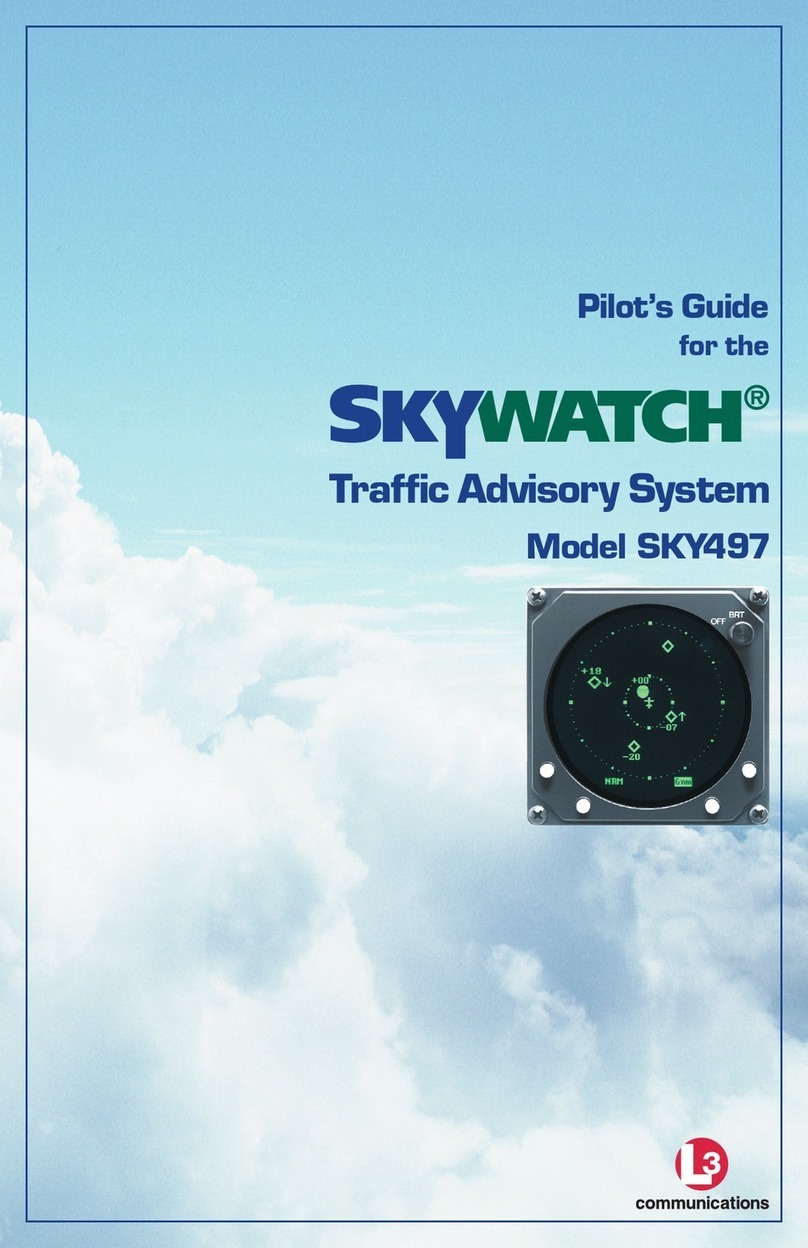
Skywatch
Skywatch SKY497 pilot's guide
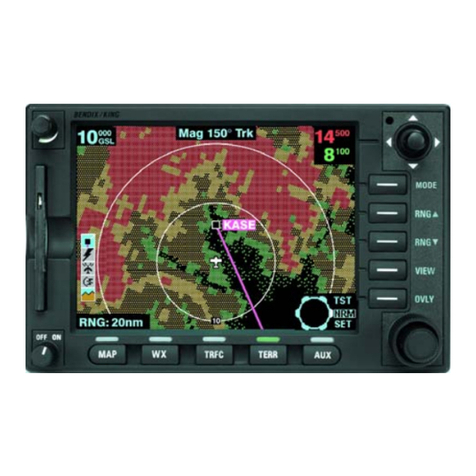
BENDIXKing
BENDIXKing KMD 550 Guide
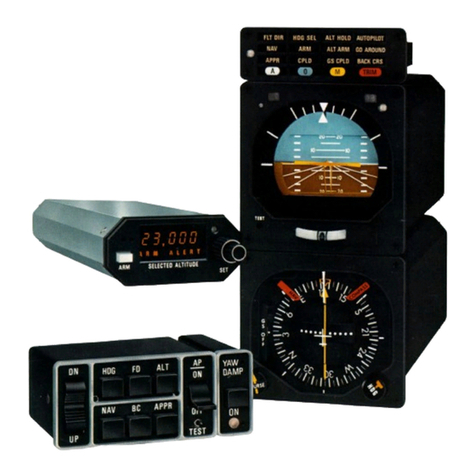
BENDIXKing
BENDIXKing Skymap IIIC pilot's guide
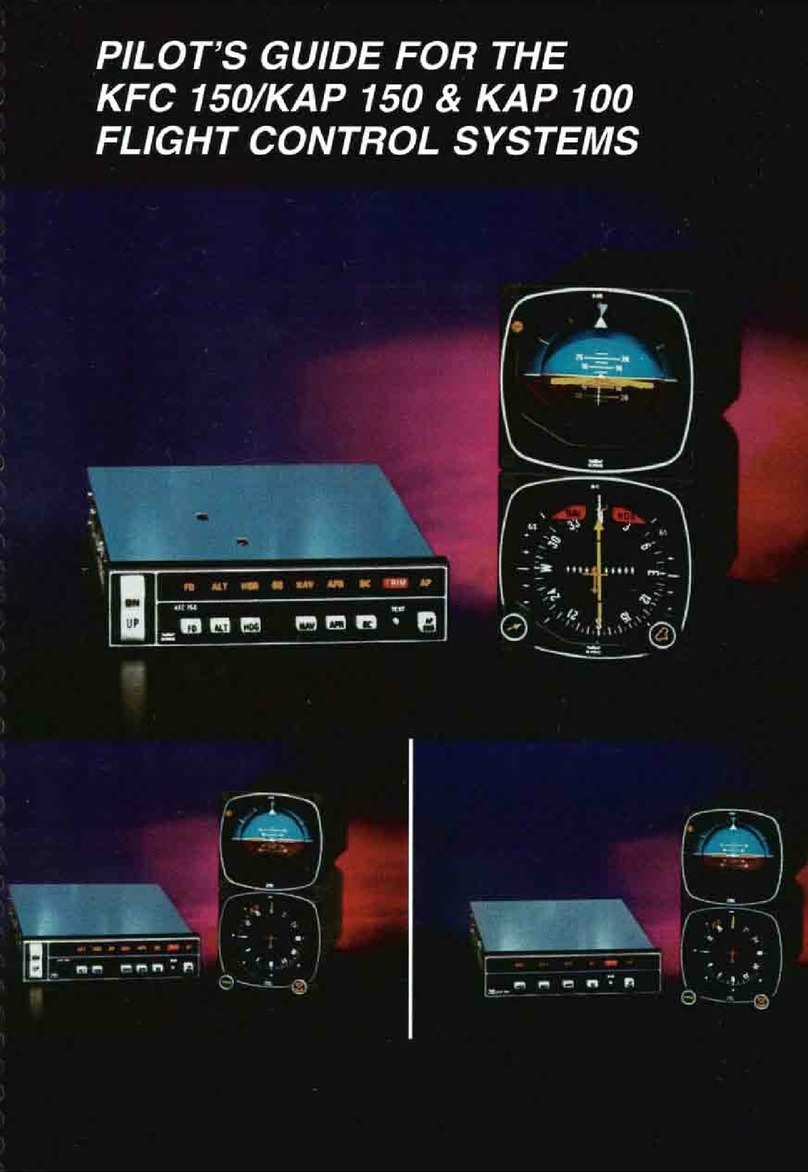
BENDIXKing
BENDIXKing KFC 150 pilot's guide

Aircatglobal
Aircatglobal VirtualFly VF-G1000 user manual
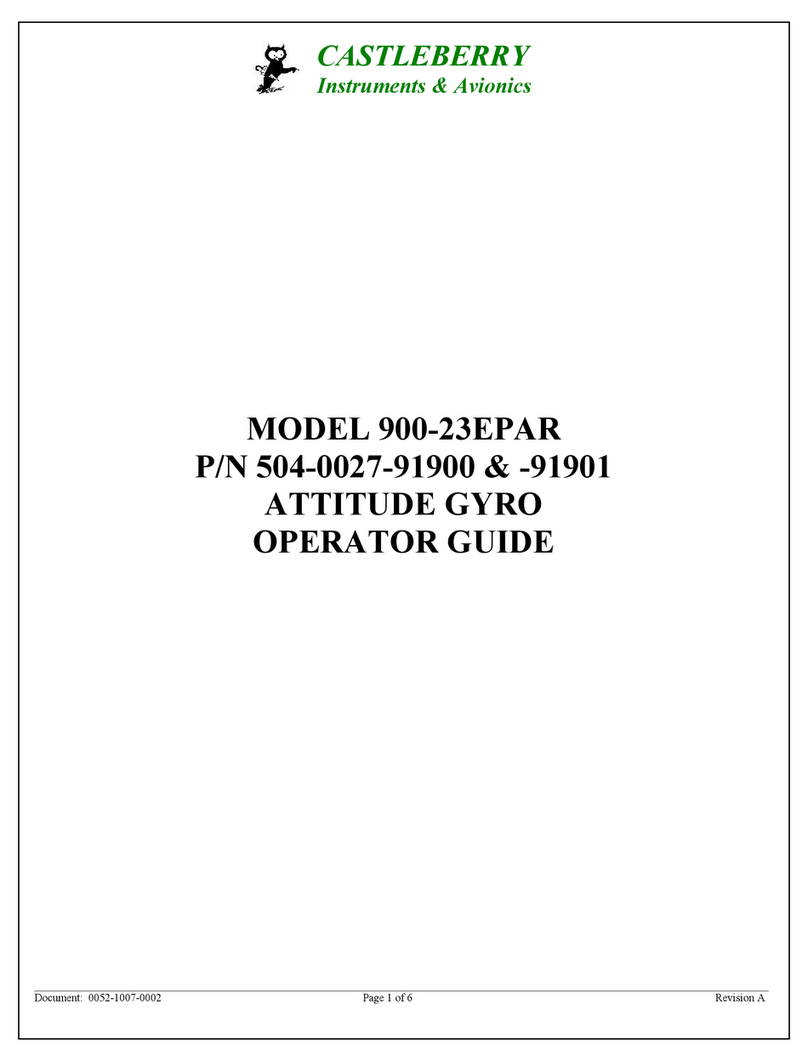
Castleberry Instruments & Avionics
Castleberry Instruments & Avionics 900-23EPAR Operator's guide

Honeywell
Honeywell KMD 250 pilot's guide

Triadis Engineering
Triadis Engineering Glide Computer and Navigation System owner's manual

Garmin
Garmin Beil 407GX Cockpit reference guide

Avidyne
Avidyne Entegra EX5000 installation manual
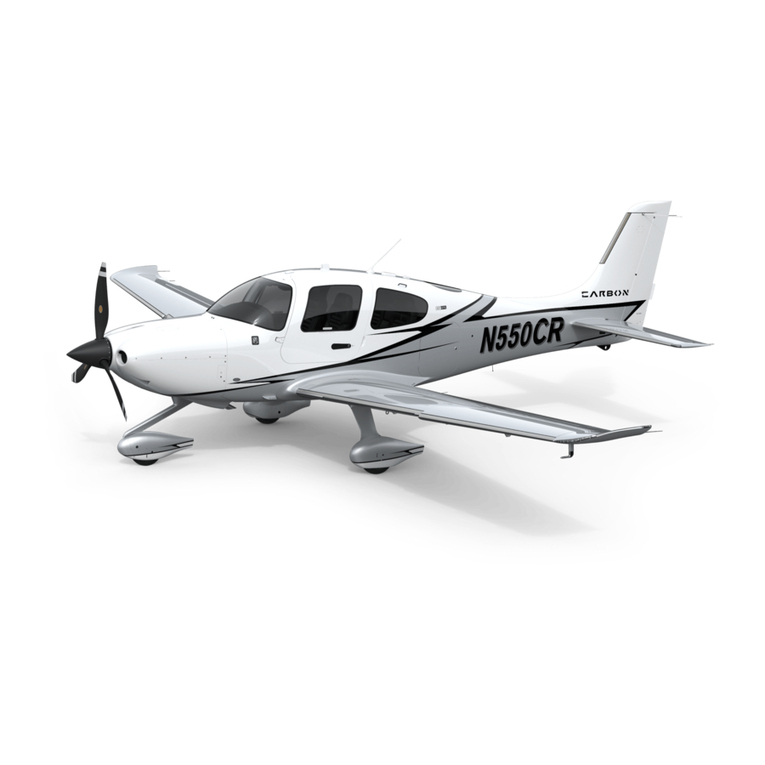
Garmin
Garmin Cirrus Perspective SR20 Cockpit reference guide
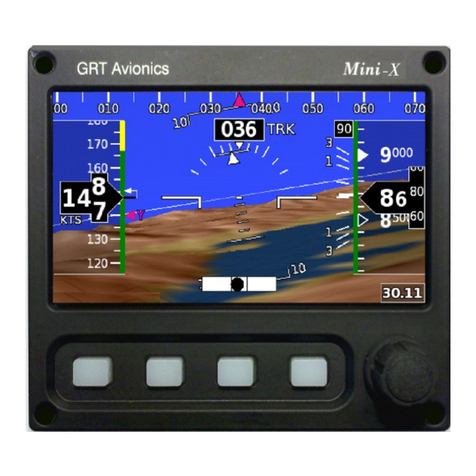
GRT Avionics
GRT Avionics Mini-X EFIS Installation & user manual
